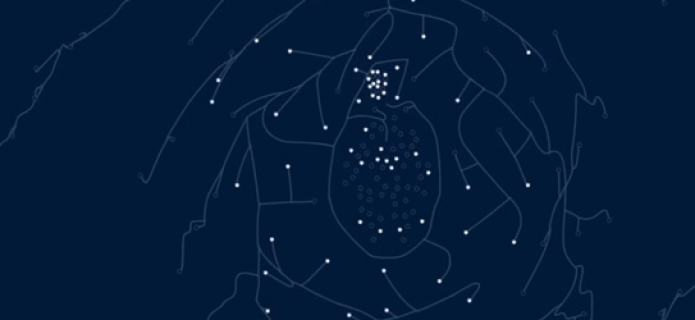Antenna dance at ALMA
All of the movements of ALMA’s antennas since September 2009–when the first one arrived at Chajnantor, at an altitude of 5,000 meters in Chile's Atacama Desert–have been charted in this one-minute, animated film that ALMA has created with the help of INRIA, the Institut National de Recherche en Informatique et en Automatique. "Information about the historical location of each antenna is very important for astronomers when reducing and studying observatory data," says Denis Barkats, an ALMA astronomer and coauthor of the animated film.
The ALMA antennas are always on the move. One of ALMA's advantages is its capacity to change the location of the antennas to create different configurations depending on observation needs. The greater the distance between the antennas, the higher the resolution of the images it obtains, although of a smaller portion of the sky. On the other hand, bringing the antennas closer to each other enables the study of larger structures in the sky, albeit with a lower level of detail. ALMA is like a camera's zoom lens, with the advantage that it can obtain both types of images by moving the antennas.
But transporting the antennas is not a simple matter, as they weigh 100 tons apiece and are high-precision instruments that require very careful handling. That’s why two transporters, Otto and Lore, were designed especially for this purpose. Each transporter has 28 wheels and power equivalent to two Formula 1 engines.
Moving an antenna requires at least six highly trained people and as the animated film shows...this has resulted in a lot of work!
More Information
The Atacama Large Millimeter/submillimeter Array (ALMA), an international astronomy facility, is a partnership of the European Organisation for Astronomical Research in the Southern Hemisphere (ESO), the U.S. National Science Foundation (NSF) and the National Institutes of Natural Sciences (NINS) of Japan in cooperation with the Republic of Chile. ALMA is funded by ESO on behalf of its Member States, by NSF in cooperation with the National Research Council of Canada (NRC) and the National Science Council of Taiwan (NSC) and by NINS in cooperation with the Academia Sinica (AS) in Taiwan and the Korea Astronomy and Space Science Institute (KASI).
ALMA construction and operations are led by ESO on behalf of its Member States; by the National Radio Astronomy Observatory (NRAO), managed by Associated Universities, Inc. (AUI), on behalf of North America; and by the National Astronomical Observatory of Japan (NAOJ) on behalf of East Asia. The Joint ALMA Observatory (JAO) provides the unified leadership and management of the construction, commissioning and operation of ALMA.
Contacts
-
Nicolás Lira
Education and Public Outreach OfficerJoint ALMA Observatory, Santiago - ChilePhone: +56 2 2467 6519Cel: +56 9 9445 7726Email: [email protected]

